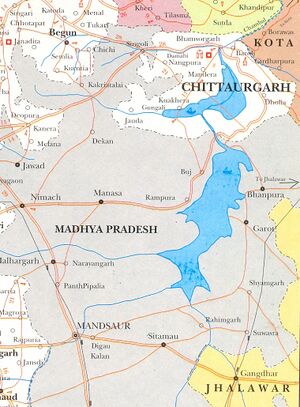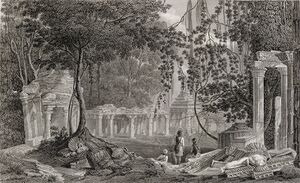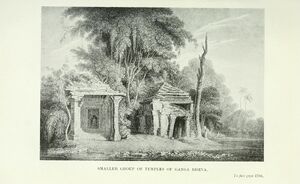Gangabheva



Gangabheva is ancient site of Mahadeva temple in Rawatbhata tahsil of Chittorgarh District in Rajasthan.
Location
It as about 50 km north of Bhanpura town of Mandsaur district in Madhya Pradesh. The temple of Gangabheva]] is not far from Baroli Chittorgarh.[1]
It is 12 miles north of Takhaji (Navali). [2]
The founders
History
James Tod[3] visited Ganga-bheva and provided us following information:
[p.656]: December 4th,1821 — The carpenters have been at work for some days hewing a road for us to pass to Ganga-bheva, another famed retreat in this wild and now utterly deserted abode. We commenced our march through a forest, the dog-star nearly south ; the river dimly seen on our right. On our left were the remains of a ruined circumvallation, which is termed Rana-Kote ; probably a rumna, or preserve. At daybreak we arrived at the hamlet of Kheyrli ; and here, our course changing abruptly to the south-east, we left the river, and continued our journey through rocks and thickets, until a deep grove of lofty trees, enclosed by a dilapidated wall, shewed that we had reached the object of our search, Ganga-bheva.
What a scene burst upon us, as we cleared the ruined wall and forced our way over the mouldering fragments of ancient grandeur ! Ganga-bheva, or 'the circle of Ganga,' appears to have been selected as a retreat for the votaries of Mahadeva, from its being a little oasis in this rock-bound valley ; for its site was a fine turf, kept in perpetual verdure by springs.
The chief object is the temple, dedicated to the creative power - it stands in the centre of a quadrangle of smaller shrines, which have more the appearance of being the cenotaphs of some ancient dynasty than domiciles for the inferior divinities. The contrast between the architecture of the principal temple, and that of the shrines which surround it, is remarkable. The body of the chief temple has been destroyed, and with its wrecks a simple, inelegant mindra has been raised ; nor is there aught of the primitive structure, except the portico, remaining. Its columns are fluted, and the entablature (part of which lies prostrate and reversed) exhibits a profusion of rich sculpture. In front of the temple is a circular basin, always overflowing, and whence the term bhevo or bheo, ' a circle,' added to the name of the spring, which is feigned to be an emanation of Ganga. The surface of its waters is covered with the flower sacred to the goddess, that particular lotus termed camodhun, which may be rendered, 'the riches of love'.
The chief temple evinces the same skill and taste as the structures of Barolli, and the embellishments are similar. We here recognize the groupes of Mahadeva and Parbutty, with the griffins (gras), the Nagunis, half-serpent, half-female, &c., though not in so finished a style as at Barolli.
Gangabheva Temple Inscription of S. 1011 (A.D. 955)
Whatever be the age of this temple (and we found on the pavement the name of a votary with the date S. 1011 (A.D. 955), it is many centuries more recent than those which surround it, in whose massive simplicity we have a fine specimen of the primitive architecture of the Hindus. Even of these, we can trace varieties. Five of these small shrines filled up each face of the quadrangle, but with the exception of those on the east side, all are in ruins. The doors of those which possess an enclosed sanctum, face inwards towards the larger shrine : and each has a simple low altar, on which are ranged the attendant divinities of Mahadeva. The sculpture of all these is of a much later
[p.657]: date than the specimens at Barolli, and of inferior execution, though far superior to anything that the Hindu sculptor of modern days can faoricate. They may possibly be of the date found inscribed (the tenth century), posterior to which no good Hindu sculpture is to be found. As this spot is now utterly deserted, and the tiger and wild boar are the only inhabitants that visit the groves of Ganga-bheva, I shall be guilty of no sacrilege in removing a few of these specimens of early art.*
Description by Edward Francis Finden
Engraving of the temples of Gunga Bheou in the forest of Puchail in Mewar by Edward Francis Finden (1791-1857) after Patrick Young Waugh (1788-1829) plate 9 of the 'Annals and antiquities of Rajast'han or the Central and Western Rajpoot States of India' published in London in 1832.
Tod wrote, 'Ganga-bheva, or 'the circle of Ganga', appears to have been selected as a retreat for the votaries of Mahadeva, from its being a little oasis in this rock bound valley. The temple dedicated to the creative power...stands in the centre of a quadrangle of small shrines. The body of the chief temple has been destroyed except the portico. Its columns are fluted and the entablature exhibits a profusion of rich sculpture. In front of the temple is a circular basin, always overflowing, and whence the term bhevo or bheo, a circle, added to the name of the spring, which is feigned to be emanation of the Ganga.'
Source - Temples of Gunga Bheou in the forest of Puchail in Mewar
External links
References
- ↑ Temples in Rajputana,p.313
- ↑ Archaeological Report
- ↑ James Todd Annals/Personal Narrative, Vol.II,p. 656
Back to Inscriptions

